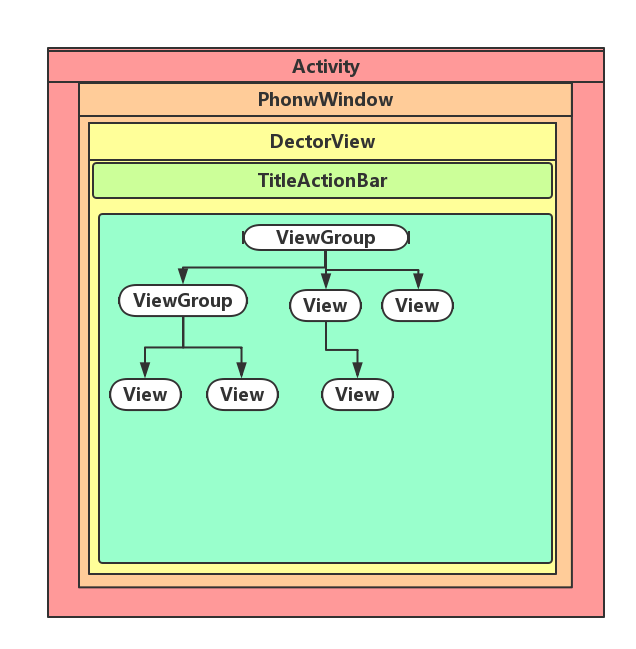转载
本文转自郭霖的专栏。
在公司各种拥抱变化,可能又要转回Android应用开发了。趁着空档的机会学习一下View的实现机制。
LayoutInfalter
首先,来看一下LayoutInflater的用法。LayoutInflater有两种写法,分别为:
- 工厂模式。
LayoutInflater mLayoutInflater = LayoutInflater.from(context);- Server模式。
LayoutInflater mLayoutInflater = (LayoutInflater)context.getSystemService(Context.LAYOUT_INFLATER_SERVICE);其实,第一种是第二种的简单写法,只是Android给我们做了一下封装而已。具体可以查看源码(/frameworks/base/core/java/android/view/LayoutInflater.java):
public static LayoutInflater from(Context context)
{
LayoutInflater LayoutInflater =
(LayoutInflater) context.getSystemService(Context.LAYOUT_INFLATER_SERVICE);
if (LayoutInflater == null) {
throw new AssertionError("LayoutInflater not found.");
}
return LayoutInflater;
}得到LayoutInflater的实例后,我们就可以通过调用它的inflate()方法来加载布局了,如下所示:
mLayoutInflater.inflate(resourceId, root);inflate方法一般接收两个参数,第一个参数是加载时的布局id,第二个参数是指给该布局的外部再嵌套一层父布局,如果不需要就直接传null。这样就成功的创建了一个布局的实例,之后再将它添加到指定的位置就可以显示出来了。
接下来,我们从源码的角度分析一下inflate函数的具体实现。
源码解析
基于Android 2.3源码进行分析(原理是一样的,而且Android 2.3代码还是容易理解一点)。源码位置:/frameworks/base/core/java/android/view/LayoutInflater.java。
public View inflate(int resource, ViewGroup root)
{
return inflate(resource, root, root != null);
}
public View inflate(int resource, ViewGroup root, boolean attachToRoot)
{
XmlResourceParser parser = getContext().getResources().getLayout(resource);
try {
return inflate(parser, root, attachToRoot);
} finally {
parser.close();
}
}
public View inflate(XmlPullParser parser, ViewGroup root, boolean attachToRoot) {
// ......最终被调用的方法
}所有调用inflate的重载的方法,最终都被调到最后的那个函数里。我们来分析一下这个最终函数的具体实现:
public View inflate(XmlPullParser parser, ViewGroup root, boolean attachToRoot)
{
synchronized(mConstructorArgs) {
final AttributeSet attrs = Xml.asAttributeSet(parser);
mConstructorArgs[0] = mContext;
View result = root;
try {
int type;
while ((type = parser.next()) != XmlPullParser.START_TAG &&
type != XmlPullParser.END_DOCUMENT) {
// Empty
}
if (type != XmlPullParser.START_TAG) {
throw new InflateException("No start tag found!");
}
final String name = parser.getName();
if (TAG_MERGE.equals(name)) {
if (root == null || !attachToRoot) {
throw new InflateException("<merge /> can be used only with a valid ViewGroup and attachToRoot=true");
}
rInflate(parser, root, attrs);
} else {
View temp = createViewFromTag(name, attrs);
ViewGroup.LayoutParams params = null;
if (root != null) {
System.out.println("Creating params from root: " + root);
params = root.generateLayoutParams(attrs);
if (!attachToRoot) {
temp.setLayoutParams(params);
}
}
System.out.println("-----> start inflating children");
rInflate(parser, temp, attrs);
System.out.println("-----> done inflating children");
if (root != null && attachToRoot) {
root.addView(temp, params);
}
if (root == null || !attachToRoot) {
result = temp;
}
}
} catch (XmlPullParserException e) {
// throw excepiton
} catch (IOException e) {
// throw exception
}
return result;
}
}这个函数还是比较简单的,主要做的事情就是:解析xml文件,得到root节点的tag,并通过createViewFromTag函数来创建root节点的view为temp,之后再调用rInflate函数,将xml剩余的tag挂到以temp为根节点的view树上。rInflate函数的具体实现如下:
private void rInflate(XmlPullParser parser, View parent, final AttributeSet attrs) throws XmlPullParserException, IOException {
final int depth = parser.getDepth();
int type;
while ((type = parser.next() != XmlPullParser.END_TAG ||
parser.getDepth() > depth) && type != XmlPullParser.END_DOCUMENT) {
if (type != XmlPullParser.START_TAG) {
continue;
}
final String name = parser.getName();
if (TAG_REQUEST_FOCUS.equals(name)) {
parseRequestFocus(parser, parent);
} else if (TAG_INCLUDE.equals(name)) {
if (parser.getDepth() == 0) {
throw new InflateException("<include /> cannot be the root element");
}
parseInclude(parser, parent, attrs);
} else {
final View view = createViewFromTag(name, attrs);
final ViewGroup viewGroup = (ViewGroup) parent;
final ViewGroup.LayoutParams params = viewGroup.generateLayoutParams(attrs);
// 递归的构造view树
rInflate(parser, view, attrs);
viewGroup.addView(view, params);
}
}
parent.onFinishInflate();
}递归的原理也很简单,终止条件是type==XmlPullParser.END_TAG。接下来,举一个简单的例子,来模拟一下LayoutInflater.inflate函数生成View数的过程。
示例layout:
<RelativeLayout>
<ImageView1 />
<TextView1 />
<LinearLayoyt>
<ImageView2 />
<TextView2 />
</LinearLayout>
</RelativeLayout>依据inflate方法的流程:
- 函数首先通过最初的Tag创建了RelativeLayout的View。然后调用了rInflate方法,传入的参数为(parser, parent=RelativeLayout, attrs);
- 进入到rInflate方法后,由于ImageView1和TextView1没有子结构,所以递归调用rInflate的时候会遇到
type==XmlPullParser.END_TAG的终止条件,因此这两个View都被add到了RelativeLayout上。 - 但是,继续向下解析的时候,到LinearLayout就不一样了。LinearLayout递归调用rInflate的时候,会把自己作为parent传入,导致解析ImageView2和TextView2的时候,均为add到LinearLayout上。最后,LinearLayout再被add到最外层root节点RelativeLayout上。
通过源码的分析,我们就比较清楚的了解inflate的实现了。还可以通过源码延伸的讲解一下attachToRoot参数的作用:
- 如果root为null,attachToRoot将失去意义,设置任何值都没有意义。
- 如果root不为null,attachToRoot为true,则会给加载的布局文件指定一个父布局,即root。
- 如果root部位null,attachToRoot为false,则会将布局文件最外层的所有layout属性进行设置,当该view被添加到父view当中时,这些layout属性会自动生效。
- 在不设置attachToRoot参数时,当root不为null,attachToRoot默认为true。
同时,附上Activity界面加载显示后的View树:























 961
961

 被折叠的 条评论
为什么被折叠?
被折叠的 条评论
为什么被折叠?








